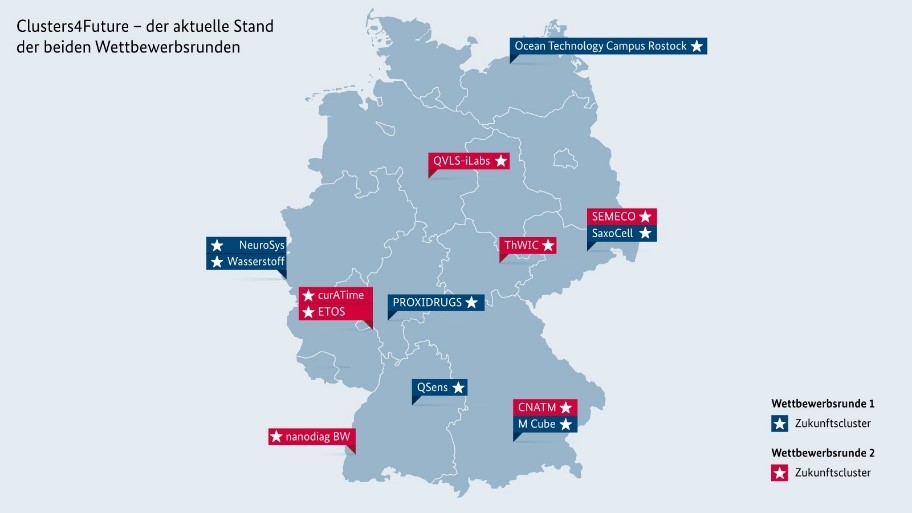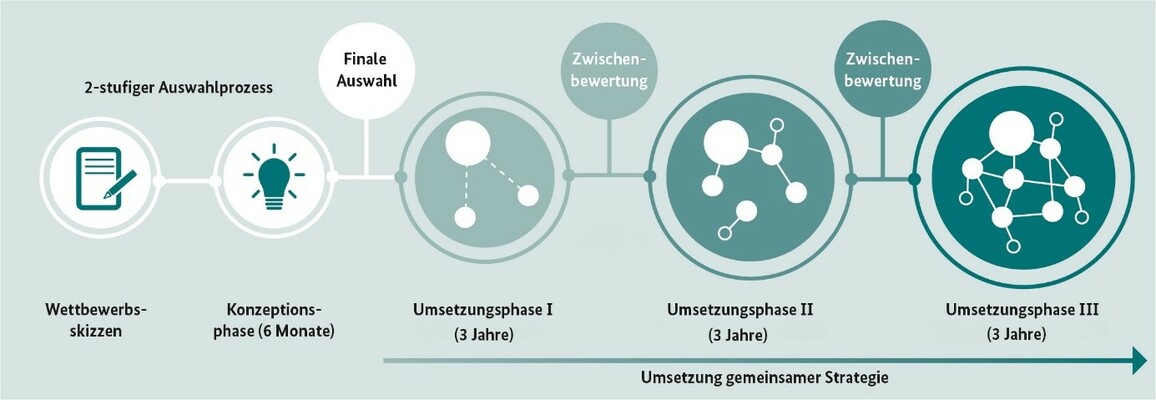Clusters4Future Initiative – next generation innovation networks : , Theme: research
Utilizing the potential of regional networks so that outstanding research can give rise to innovations for the future – this is the mission of the Clusters4Future initiative.
The Vision
The Clusters4Future initiative was launched in 2019 with the aim of stimulating new value creation in Germany. This will reinforce Germany’s position as one of the world’s innovation leaders.
Germany's universities and research institutions are already excellent in a wide range of research fields. What we also need are intelligent minds, teams that collaborate well together and convincing concepts in order to transform fundamental research into market-ready solutions – especially in emerging knowledge areas and research fields. The focus is on regional innovation networks that bring together the various perspectives and skills in a region. They are creating the innovation centres of tomorrow.
These clusters are the key to the rapid translation of excellent research into innovations that benefit citizens directly. Each cluster concentrates on mastering challenges with pioneering solutions for the future, such as: How can we make the transition to sustainable mobility succeed in urban and rural areas? Which personalized approaches in medicine can best help patients? How can a resource-efficient circular economy ensure a clean and affordable water supply? How can we exploit the world's oceans in harmony with the needs of nature and climate protection? These and other questions are addressed by the innovation policy goals and missions of the Federal Government's Future Research and Innovation Strategy.
The Principle of Openness
Our next generation innovation networks link thematic and technological openness with an open innovation culture, which is virtually unrivalled in the world. In Germany, this link is regarded as one of the basic factors for the successful transfer of research into application.
The next generation innovation networks are more dynamic and less risk-averse than any cluster structure previously funded. This is where science, business, and society step out of their comfort zones. They overcome systemic boundaries and create new interfaces in emerging technology and knowledge fields.
The continuously developing networks tap into the full potential of their region. Their individual structures and a jointly coordinated strategy also enable long-term cooperation based on trust. Start-ups, small and medium-sized enterprises (SMEs), large corporations, and civil society players including municipalities engage on an equal footing. This results in cross-sectoral, cross-topic, cross-technology, and cross-disciplinary collaborations that are particularly flexible and resilient to crises.
Clusters4Future Competition Rounds
Under the title “Clusters4Future”, the competition to find the best ideas for new value creation in Germany was launched in summer 2019.From a total of 137 cluster outlines, 16 finalists were chosen for a funded six-month conceptual phase. In February 2021, an independent expert jury recommended the first seven next generation innovation networks for funding based on these concepts. In January 2022, all seven clusters from the first round of competition entered their implementation phase.
In a second round of competition entries, starting in November 2020, 15 finalists were chosen from a total of117 cluster ideas. In July 2022, the jury determined the next seven clusters, all of which entered their first implementation phase at the beginning of 2023.
Currently, there are 14 next generation innovation networks, which may undergo a maximum of three implementation phases, each lasting up to three years. Each phase sees an expansion of partner structures and an increase in own financial contributions. In particular the transitions between phases are scrutinized by an independent jury. It evaluates the continued "cluster strategies" (research and innovation strategies) and project proposals for continued implementation, sometimes with the aid of additional expert evaluations and opinions.
The map of Germany shows the locations of the next generation innovation networks from the first and second competition rounds. Further information on the Clusters4Future initiative and the former finalists can be found at clusters4future.de
Funding
How does the funding work, and what are the criteria for selecting the next generation innovation networks? Key questions and answers.
What are the goals of the Clusters4Future funding?
Fundamental results from cutting-edge research that are on the verge of application should be quickly transferred into successful products, processes, and services. The focus is not only on individual technological or social innovations. More important is that different players from a particular region complement each other in exploiting the results of research. And together, they create new innovation and value networks. In general, the competition is open for any topic with the focus on potential solutions for the major societal challenges.
How does society benefit from the results of the Clusters4Future initiative?
The initiative connects regional stakeholders from science, business and society on the basis of promising research results. In this way, new fields of technology and knowledge can be further developed. At the same time, initial results from these research fields are transferred more quickly into practical application. Society will benefit directly from these innovations.
What do the funded projects look like?
Recent research results with high breakthrough potential should provide the basis for the next generation innovation networks to develop at Germany's scientific hotspots. In each round of competition, the selected finalists (15 in the first round; 16 in the second round) have the opportunity to develop a viable "cluster strategy" (research and innovation strategy) during a six-month concept development phase. The concept development phase is funded with a maximum of €250,000 (including project lump sum), alongside an own financial contribution of 20 percent. The most convincing cluster concepts will be chosen for funding as next generation innovation networks. The selected clusters will then be given the opportunity to implement their strategies for a maximum of three consecutive funding periods of up to three years each.
In the implementation phase, a varying number of R&D projects are funded. The projects draw from the range of topics in the respective cluster and are flanked by innovation-supporting measures, focusing, for example, on data platforms, gender issues, start-ups or other higher-level structures.
What stakeholders actually receive funding?
Usually, the Clusters4Future projects are initially located at the universities and research institutions that submit the funding applications. Companies with a strong focus on research (including start-ups, SMEs and large enterprises) are also involved from the beginning. Over time and the closer the project gets to application, other previously underrepresented stakeholders, for example, from civil society, will join the cluster. They all collaborate dynamically in the spirit of an open innovation culture. As a result, each cluster not only grows in terms of numbers but also becomes more interconnected.
May existing clusters, e.g., Leading-Edge Clusters, apply for funding?
Previous initiatives, such as the Leading-Edge Cluster Competition, address existing innovation regions that are already fairly well developed and economically successful in a specific topic or technology field. With the Clusters4Future initiative, we start the innovation process at an earlier stage and build the leading-edge clusters of tomorrow. Nevertheless, established regions and their proven stakeholders can also be successful in this initiative if they adopt new, possibly even disruptive perspectives for their specific subject and expand the range of stakeholders beyond organizational, professional and thematic boundaries. This initiative is about creating new cooperative structures and transdisciplinary approaches.
How do we ensure that the clusters successfully implement their strategies?
During the implementation phases, the next generation innovation networks must, among other things, submit strategic progress reports. Moreover, further applications for project funding in the following period have to be submitted for evaluation on the basis of an updated strategy. The independent, expert-led jury will then make a recommendation concerning the continuation of funding. In total, funding may be granted for three 3-year periods.
What is the envisaged financial framework?
The Federal Government intends to provide up to €630 million in total for the first two rounds of competition. Taking into account the follow-up investments stimulated by the measure, the Clusters4Future initiative could result in the investment of over one billion euros in research and development (R&D) within the next ten years. For each of the three consecutive three-year implementation phases, every cluster can receive up to €5 million per year (including project lump sum) in funding.


